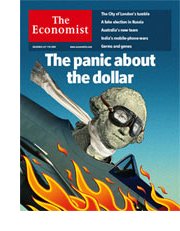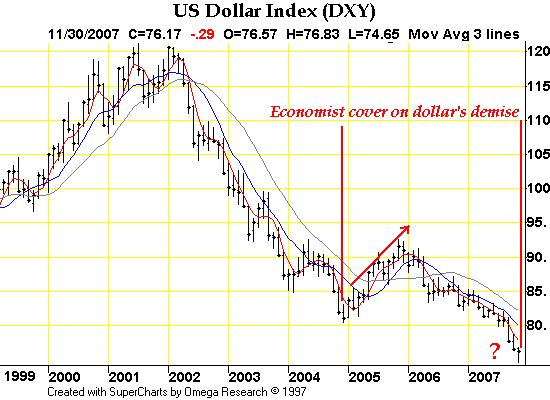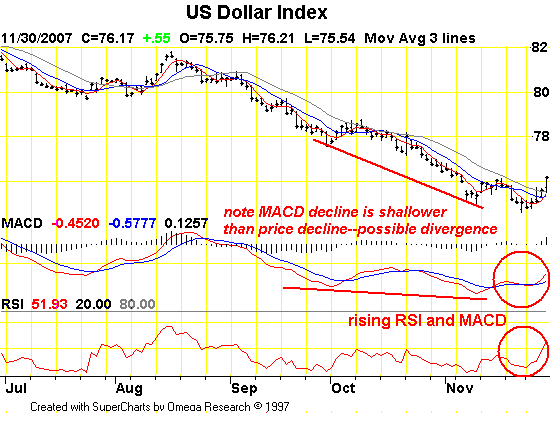

|
| weblog/wEssays archives | home | |
|
The Economist Cover Dollar Indicator (December 3, 2007) Back in December 2004, the dollar swooned to 80 on the Dollar Index (DXY), and The Economist magazine ran a cover suggesting the dollar's demise. As the chart below shows, the dollar shrugged off its lethargy shortly after and climbed 15% over the next year.  Was this a long-term reversal? No, as the dollar resumed its decline a year later. But in
the meantime, all those betting against the dollar suffered losses for over a year.
Was this a long-term reversal? No, as the dollar resumed its decline a year later. But in
the meantime, all those betting against the dollar suffered losses for over a year.
Here is the current cover of The Economist. Need I say more? Below is a chart of the dollar with the date of the previous Economist Cover Indicator. My first market mentor used to say that it's never what the market already knows that causes big moves, it's what the market doesn't know. As this cover indicates, the market knows all about the dollar's weakness and its structural woes. Therefore it behooves us to ask: what might cause the dollar to again shrug off the universally negative sentiment and actually rise by 15% or more? 
Two frequent contributors sent in very interesting comments which help elucidate just how the dollar might strengthen despite the nearly universal opinion that it is doomed. Here are Protagoras's cogent comments: If there is a greater bubble than the US one, with more corrupt lending and worse accounting, its the Chinese one. When this one bursts, a flood of money might well flow back into relative safety of dollars. Accounts of the dollar's short term death might be premature. It might spike amazingly before it goes bad.Albert T. contributed a link about China's Sovereign Fund and added his astute observations: Great wall of money: $250 billion to flow from ChinaCould non-U.S. capital provide a possible prop for the dollar? If all these Sovereign Funds/ government-mandated pools of capital start buying assets--total assets in these funds are supposedly in the $1.2 trillion range and estimated to reach $5+ trillion in a few years--some will surely be made in in the U.S. (25% of global GDP), especially if the weak dollar has put some U.S. assets "on sale." These investments would be made in dollars, meaning the funds have to buy dollars to make the investments. That would serve to strengthen the dollar, regardless of how other currencies were performing vis a vis the dollar. And as Protagoras observes, the dollar (and by proxy, the U.S.) doesn't have to be safe--it needs only to be perceived as safer for a relatively short period of time. Here is a short-term chart of the dollar, and an interesting link from frequent contributor U. Doran on the dollar and oil: 
The Epic Battle Over Crude Oil and the US$ (by Gary Dorsch, FinancialSense.com) Thank you, Protagoras, Albert T. and U. Doran for contributing to our understanding of the dollar's moves--and a hat-tip to The Economist for the infallible Cover Indicator. Thanks to you, readers, this small outpost on the Great Worldwide Web received over 100,000 visits (by 51,826 unique visitors) last month--the first time it has been so honored by more than 100,000 readers. Thank you, Tom S., ($50), for your outrageously generous third contribution to this humble site. I am greatly honored by your readership and support. All contributors are listed below in acknowledgement of my gratitude. For more on this subject and a wide array of other topics, please visit my weblog. copyright © 2007 Charles Hugh Smith. All rights reserved in all media. I would be honored if you linked this wEssay to your site, or printed a copy for your own use. |
||
| weblog/wEssays | home |